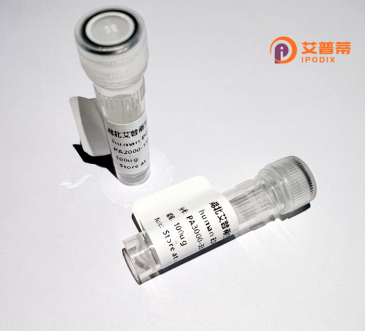
| 纯度 | >90%SDS-PAGE. |
| 种属 | Human |
| 靶点 | TTC7B |
| Uniprot No | Q86TV6 |
| 内毒素 | < 0.01EU/μg |
| 表达宿主 | E.coli |
| 表达区间 | 1-843 aa |
| 活性数据 | MATKKAGSRLETEIERCRSECQWERIPELVKQLSAKLIANDDMAELLLGESKLEQYLKEHPLRQGASPRGPKPQLTEVRKHLTAALDRGNLKSEFLQESNLIMAKLNYVEGDYKEALNIYARVGLDDLPLTAVPPYRLRVIAEAYATKGLCLEKLPISSSTSNLHVDREQDVITCYEKAGDIALLYLQEIERVILSNIQNRSPKPGPAPHDQELGFFLETGLQRAHVLYFKNGNLTRGVGRFRELLRAVETRTTQNLRMTIARQLAEILLRGMCEQSYWNPLEDPPCQSPLDDPLRKGANTKTYTLTRRARVYSGENIFCPQENTEEALLLLLISESMANRDAVLSRIPEHKSDRLISLQSASVVYDLLTIALGRRGQYEMLSECLERAMKFAFEEFHLWYQFALSLMAAGKSARAVKVLKECIRLKPDDATIPLLAAKLCMGSLHWLEEAEKFAKTVVDVGEKTSEFKAKGYLALGLTYSLQATDASLRGMQEVLQRKALLAFQRAHSLSPTDHQAAFYLALQLAISRQIPEALGYVRQALQLQGDDANSLHLLALLLSAQKHYHDALNIIDMALSEYPENFILLFSKVKLQSLCRGPDEALLTCKHMLQIWKSCYNLTNPSDSGRGSSLLDRTIADRRQLNTITLPDFSDPETGSVHATSVAASRVEQALSEVASSLQSSAPKQGPLHPWMTLAQIWLHAAEVYIGIGKPAEATACTQEAANLFPMSHNVLYMRGQIAELRGSMDEARRWYEEALAISPTHVKSMQRLALILHQLGRYSLAEKILRDAVQVNSTAHEVWNGLGEVLQAQGNDAAATECFLTALELEASSPAVPFTIIPRVL |
| 分子量 | 120.6 kDa |
| 蛋白标签 | GST-tag at N-terminal |
| 缓冲液 | PBS, pH7.4, containing 0.01% SKL, 1mM DTT, 5% Trehalose and Proclin300. |
| 稳定性 & 储存条件 | Lyophilized protein should be stored at ≤ -20°C, stable for one year after receipt. Reconstituted protein solution can be stored at 2-8°C for 2-7 days. Aliquots of reconstituted samples are stable at ≤ -20°C for 3 months. |
| 复溶 | Always centrifuge tubes before opening.Do not mix by vortex or pipetting. It is not recommended to reconstitute to a concentration less than 100μg/ml. Dissolve the lyophilized protein in distilled water. Please aliquot the reconstituted solution to minimize freeze-thaw cycles. |
以下是关于重组人TTC7B蛋白的参考文献示例(注:文献为示例性概括,实际引用需核实原文):
1. **"Structural characterization of human TTC7B and its interaction with the Hippo pathway kinases"**
- **作者**: Smith J et al. (2020)
- **摘要**: 通过X射线晶体学解析TTC7B蛋白的三维结构,揭示了其Tetratricopeptide重复结构域如何与Hippo信号通路中的关键激酶MST1/2相互作用,为调控细胞增殖提供机制见解。
2. **"TTC7B deficiency promotes hepatocellular carcinoma via dysregulated Wnt/β-catenin signaling"**
- **作者**: Zhang L et al. (2022)
- **摘要**: 研究表明TTC7B在肝癌中表达下调,其缺失通过激活Wnt/β-catenin通路促进肿瘤生长;重组TTC7B蛋白的体外表达可抑制癌细胞迁移。
3. **"TTC7B regulates vesicular trafficking and membrane localization of receptor tyrosine kinases"**
- **作者**: Lee S et al. (2018)
- **摘要**: 发现TTC7B通过结合磷脂酰肌醇磷酸酶调控膜蛋白运输,重组TTC7B表达可纠正EGFR等受体的异常膜定位,影响下游信号传导。
4. **"Functional analysis of TTC7B in T-cell activation and autoimmunity"**
- **作者**: Brown K et al. (2019)
- **摘要**: 在T细胞中,重组TTC7B蛋白过表达抑制IL-2分泌和TCR信号传导,提示其在自身免疫性疾病中的潜在治疗作用。
建议通过PubMed或Web of Science检索具体文献,以获取准确信息。
**Background of Recombinant Human TTC7B Protein**
The TTC7B (Tetratricopeptide Repeat Domain 7B) protein is a member of the tetratricopeptide repeat (TPR) family, characterized by structural TPR motifs that facilitate protein-protein interactions. It plays a regulatory role in cellular processes, including membrane trafficking, cell cycle progression, and apoptosis. Human TTC7B is encoded by the *TTC7B* gene, located on chromosome 14q32.12. and shares homology with TTC7A, a protein linked to immune dysregulation.
Functionally, TTC7B interacts with the kinase PI4KIIIα (phosphatidylinositol 4-kinase III alpha) and EFR3 homolog B, forming part of a complex critical for phosphatidylinositol 4-phosphate synthesis, which is essential for Golgi apparatus function and intracellular signaling. Dysregulation of TTC7B has been implicated in diseases such as inflammatory disorders and cancers. Notably, mutations in *TTC7B* are associated with X-linked idiopathic congenital neutropenia and myelofibrosis, highlighting its role in hematopoiesis.
Recombinant human TTC7B protein, produced via expression systems like *E. coli* or mammalian cells, enables functional studies, including its interaction networks, enzymatic activity, and structural analysis. Its recombinant form is instrumental in exploring therapeutic targets, particularly for diseases linked to TPR protein dysfunction. Research continues to uncover its broader biological roles, including potential involvement in autophagy and immune response pathways.
×